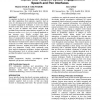Free Online Productivity Tools
i2Speak
i2Symbol
i2OCR
iTex2Img
iWeb2Print
iWeb2Shot
i2Type
iPdf2Split
iPdf2Merge
i2Bopomofo
i2Arabic
i2Style
i2Image
i2PDF
iLatex2Rtf
Sci2ools
CHI
2008
ACM
2008
ACM
Implicit user-adaptive system engagement in speech and pen interfaces
As emphasis is placed on developing mobile, educational, and other applications that minimize cognitive load on users, it is becoming more essential to base interface design on implicit engagement techniques so users can remain focused on their tasks. In this research, data were collected with 12 pairs of students who solved complex math problems using a tutorial system that they engaged over 100 times per session entirely implicitly via speech amplitude or pen pressure cues. Results revealed that users spontaneously, reliably, and substantially adapted these forms of communicative energy to designate and repair an intended interlocutor in a computer-mediated group setting. This behavior was harnessed to achieve system engagement accuracies of 75-86%, with accuracies highest using speech amplitude. However, students had limited awareness of their own adaptations. Finally, while continually using these implicit engagement techniques, students maintained their performance level at solvi...
CHI 2008 | Human Computer Interaction | Implicit Engagement Techniques | Pen Pressure | Speech Amplitude |
| Added | 12 Oct 2010 |
| Updated | 12 Oct 2010 |
| Type | Conference |
| Year | 2008 |
| Where | CHI |
| Authors | Sharon L. Oviatt, Colin Swindells, Alexander M. Arthur |
Comments (0)

